You can fill up a garden with shrubs and groundcover, but there’s nothing like flowering trees to make a visual impact.
Surprisingly, there are varieties for every season.
There are smaller varieties of flowering trees for limited space or full-grown trees for gorgeous flower clusters.
Here are the top flowering trees in Australia to provide brightness and colour, no matter what time of year.
Pink Flower Trees | Purple Flower Trees | White Flower Trees | Yellow Flower Trees | Red Flower Trees | Multi-Colour Flower Trees
Pink Flowering Trees
Cape Chestnut Trees
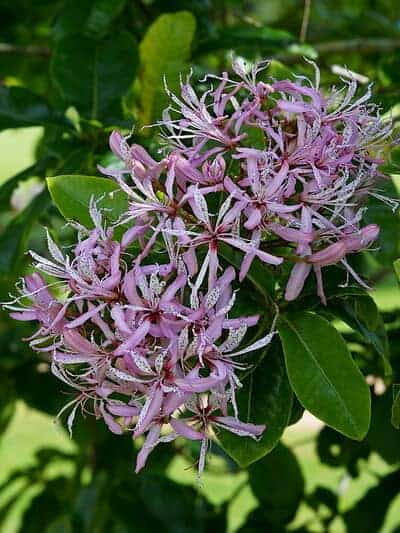
Cape Chestnuts are slow-growing evergreens that can reach a height of 12 metres, so they’re not for small gardens!
But they’re perfect for summer flowers, as Cape Chestnuts produce large, shower clusters of pink to lavender flowers in the late spring to early summer.
Given its striking appearance, especially when in bloom, the Cape Chestnut is popular as an ornamental tree in gardens and parks.
Their branches grow wide, so they make excellent shade trees, too.
Cape Chestnut trees adapt to most soil types as long as there’s good drainage — just make sure to keep the ground moist and well-mulched.
Cherry Blossom Trees
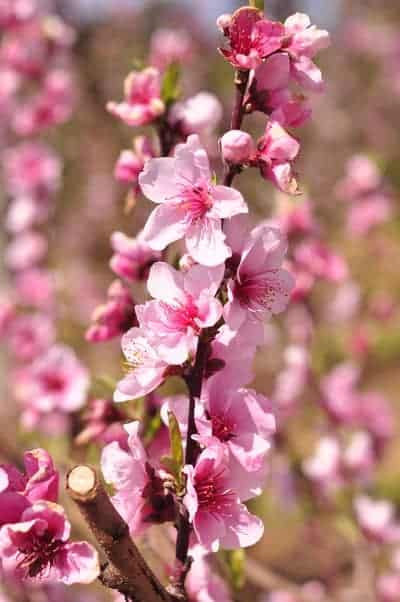
The sight of a flowering cherry tree is an iconic symbol of Japan, but you can have one down under too.
Cherry blossom trees thrive in temperate climates, or even those with cold winters and mild summers.
Plant a cherry tree somewhere sunny, in deep, well-drained soil.
Make sure to choose a size and species appropriate for your yard.
There are cherry blossom varieties that grow as short as 3 metres, perfect for smaller gardens.
Water and fertilise your cherry blossom tree regularly, and be rewarded with that brief but breathtaking display of pink flowers so beloved around the globe.
Peach Myrtle Trees
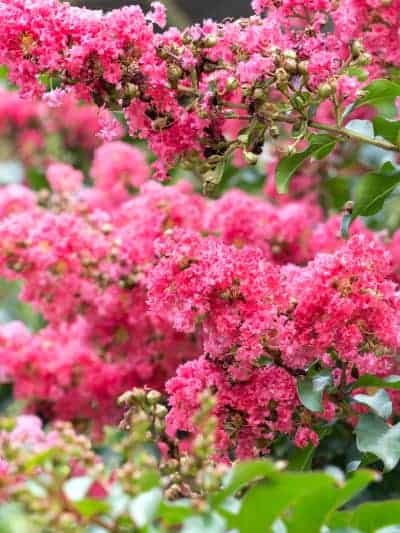
Native to Australia, the Peach Myrtle is a small evergreen tree or large shrub often found in tropical rainforests. It offers a year-round verdant display.
This tree does best in well-draining soils and can grow from 4–12 metres.
The Peach Myrtle usually blooms from spring to summer, producing delicate pink to peachy flowers.
These bell-shaped flowers hang in clusters and are followed by edible berries.
Beyond being a sight to behold, Peach Myrtle flowers hold ecological significance, too.
Its flowers are a magnet for pollinators such as bees and butterflies, while its berries provide sustenance to various bird species.
Pink Trumpet Trees
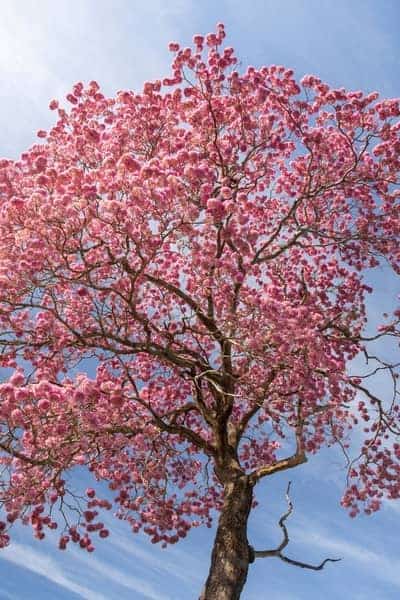
The Pink Trumpet Tree is cherished for its vibrant pink, trumpet-shaped flowers that create a spectacular display in winter.
This South American native can grow up to 10–15 metres, but in its original habitat, it can tower up to 25 metres tall.
It blooms in winter, offering a splash of colour when most other trees are dormant.
The blossoms are arranged in clusters, creating a striking visual against its attractive foliage.
The Pink Trumpet tree’s hardwood is also valued for its durability.
Purple Flowering Trees
Jacaranda Trees
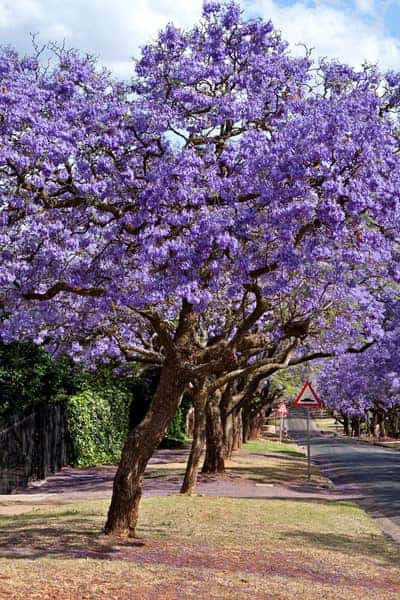
The Jacaranda is a symbol of spring in Australia, with its lush, purple blooms creating floral canopies in parks and along streets.
These trees are highly valued for their spectacular, long-lasting, violet-blue blossoms.
Jacarandas are not for small gardens as they can grow up to 15 metres in height.
These flowering trees burst into beautiful lilac bloom in early October through November.
Beyond their flowers, they’re excellent shade trees in summer, and their leaves are a gorgeous yellow spray in autumn, so they’re picture-perfect year-round.
Jacarandas thrive best in warmer or more temperate climates.
Royal Purple Magnolia Trees
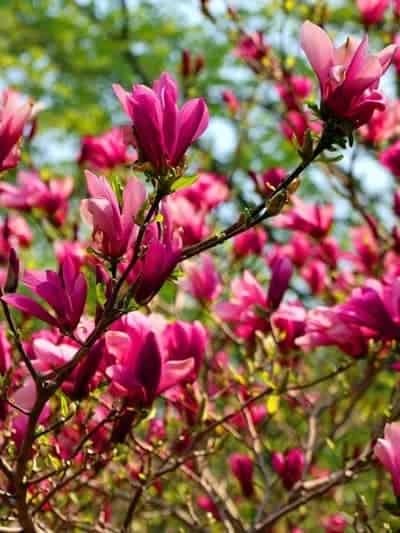
Although not native to Australia, the Royal Purple Magnolia is favoured for its deep purple-pink flowers.
The Royal Purple Magnolia is a particularly dark-coloured cultivar of the saucer magnolia and can reach heights of up to 6 metres.
It’s known for its large, tulip-shaped flowers that bloom in late winter to spring.
The inner petals are deep purple-pink, providing a dramatic contrast with the paler outer petals.
The Royal Purple Magnolia’s flowers bloom first before its glossy green leaves emerge.
Purple Orchid Trees
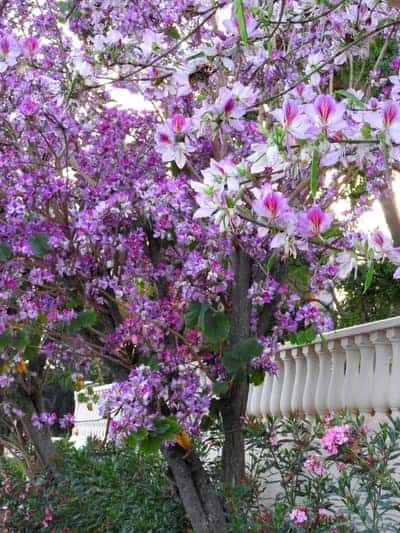
Hailing from Southeast Asia, the Purple Orchid Tree is a flowering deciduous tree that can reach heights up to 7 metres.
Its ornate, orchid-like deep purple flowers typically bloom in late summer to early winter.
The Purple Orchid tree also features twin-lobed leaves, which give it a unique appearance.
This is a great ornamental tree, offering both aesthetic pleasure and shade.
Tibouchina ‘Alstonville’
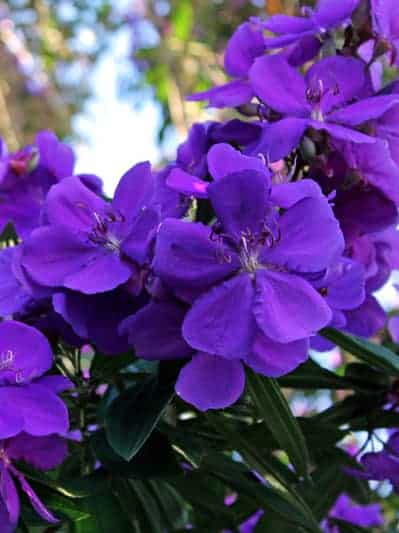
This type of Tibouchina is a smaller, more compact flowering tree, usually growing up to 5 metres.
It’s adorned with large, vibrant purple flowers in late summer and autumn.
Each petal offers a velvety texture and a distinct, almost geometric shape.
The Alstonville has large and vibrant blooms, making it a popular choice for gardens and public displays.
This tree thrives in well-drained soil and under full sun, ideally in a warm sheltered garden that isn’t exposed to frost.
White Flowering Trees
Ivory Curl Trees
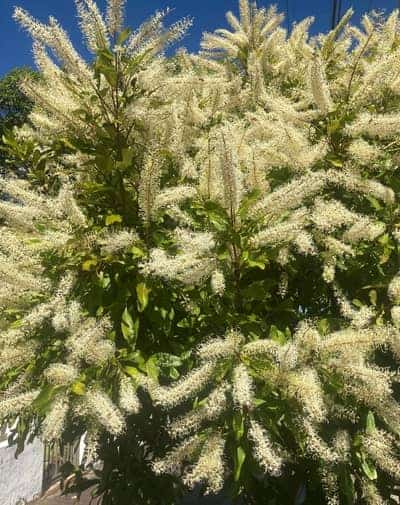
The Ivory Curl is an Australian native tree, making it well-suited to warm climates, although it’ll also tolerate mild frost.
These plants will do well in regular soil, but top with plenty of organic matter and ensure good drainage.
Their long, cream-coloured blossoms resemble tassels and curl out from branches and leaves for a classy display.
Keep your Ivory Curl tree in full sun to partial shade. After it’s established, it’s fairly drought-tolerant.
As for height — the warmer the climate, the taller your tree!
Mock Orange
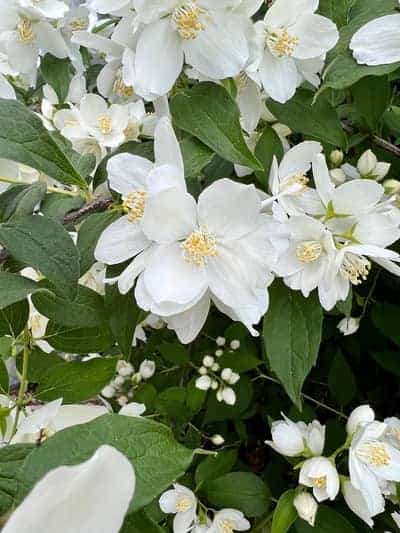
The Mock Orange is known for its delightful citrusy fragrance and abundance of flowers in late spring.
Though not a native, it is a popular medium-sized ornamental shrub in Australia, growing up to 3 metres tall.
It’s a deciduous tree with creamy-white, fragrant flowers that bloom in late spring.
The Mock Orange gets its name from its flowers because they look like orange blossoms despite being white.
Yellow Flowering Trees
Forsythia Trees
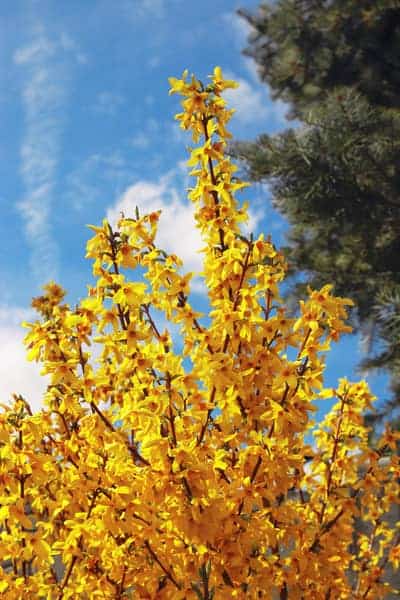
Forsythia bursts into bloom starting in late winter, even in the cold when nothing else emerges.
These go-getter flowers actually need a cold winter to best produce their stunning yellow blossoms.
Fortunately, Forsythia trees are otherwise low-maintenance, thriving in any type of soil as long as it’s well-mulched.
Keep them in full sun and let them grow to their full 3-metre height, bringing you golden flowers that herald the start of spring.
Golden Wattle
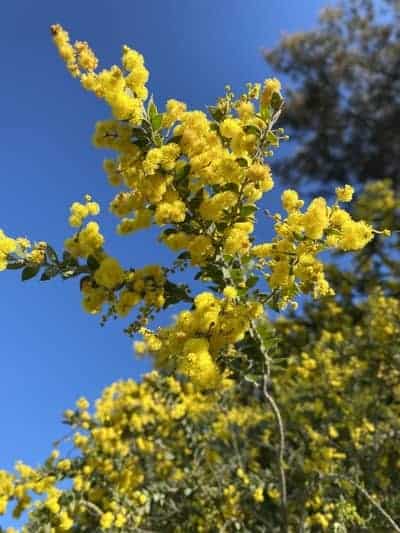
That’s right — you can plant the national floral emblem right in your own garden.
In full blossom, this tree’s gold clusters look absolutely stunning.
A wattle tree grows easily and quickly and produces plentiful flowers — just make sure you get the species that grows in winter, not spring!
Golden Wattles are great to grow because they restore nitrogen to the earth, and their blossoms and branches offer winter shelter to animals.
Tuckeroo
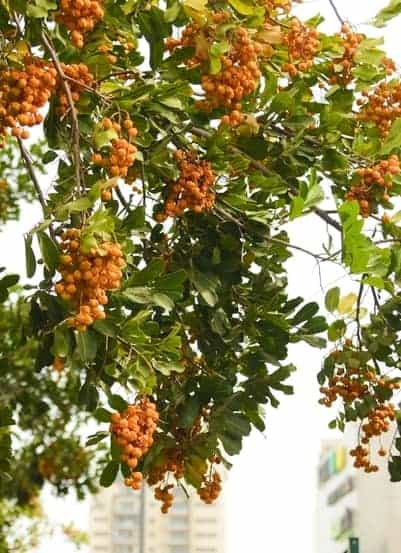
The Tuckeroo is an Australian native known for its resilience. It’s commonly found along coastal areas.
It is an evergreen flowering tree that typically grows to around 8–10 metres in height, but it can reach up to 15 metres in optimal conditions.
The tree has a rounded canopy with glossy, dark green, lance-shaped leaves.
Young Tuckeroo tree leaves often have an attractive reddish tint before they mature.
The Tuckeroo produces small, inconspicuous yellowish-green flowers that cluster together in panicles.
While they might not be the showiest of blooms, they play a significant role in the tree’s reproductive process.
Tuckeroo trees produce green rounded fruit capsules that turn a distinctive orange or yellow as they mature.
Red Flowering Trees
Bottlebrush
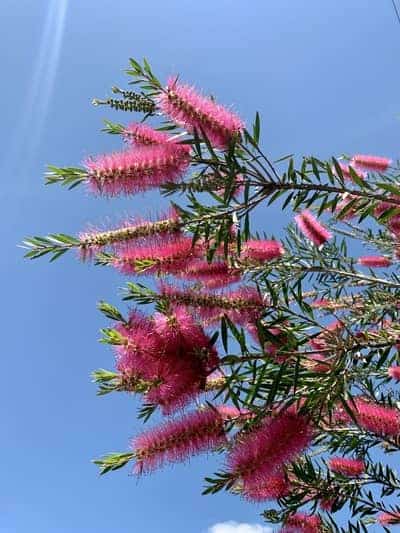
Bottlebrush trees are quintessentially Australian, bearing bright red, brush-shaped flowers primarily during spring and early summer.
The tree gets its name from its distinct cylindrical, red, brush-like flowers.
Bottlebrush trees are hardy plants that are able to grow up to 15 metres. However, they are typically found in smaller gardens or along streets.
Bottlebrush flowers are visually appealing and a vital source of nectar for various native birds and insects.
Crabapple Trees
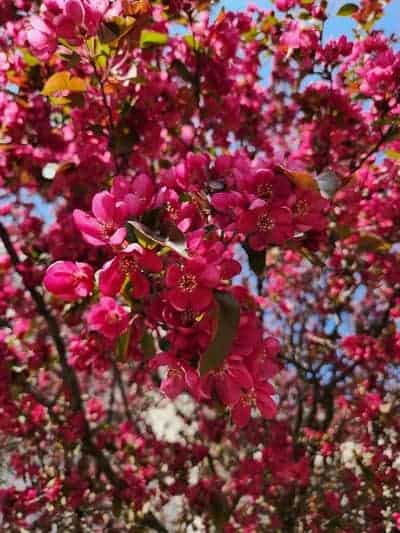
A flowering crabapple tree will attract bees to your garden in early spring (which is good!) with bunches of blossoms.
They come in a range of gorgeous colours, from deep pink to vivid red to white.
This deciduous tree can grow from 3–6 metres depending on the variety.
Crabapple trees tolerate frost and drought, but make sure the ground drains well and give them a layer of mulch.
Illawarra Flame Tree
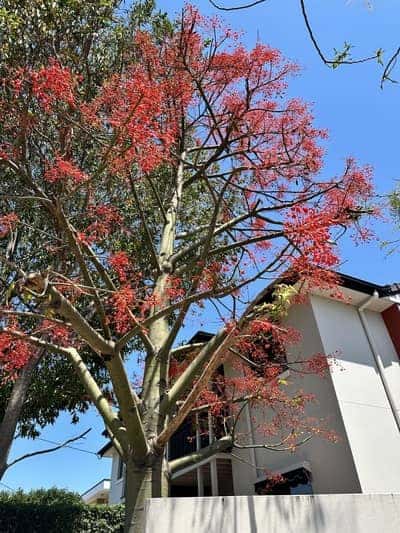
The Illawarra Flame Tree is renowned for its bright red bell-shaped flowers that look like a bonfire when the tree is leafless.
It’s a deciduous tree native to the eastern parts of Australia. It offers a brilliant contrast when planted near a Jacaranda.
The Illawarra Flame Tree offers a spectacular display in late spring and early summer with its scarlet-red bell-shaped flowers.
The Illawarra Flame is also one of the fastest growing flowering trees.
Red Flowering Gum Tree
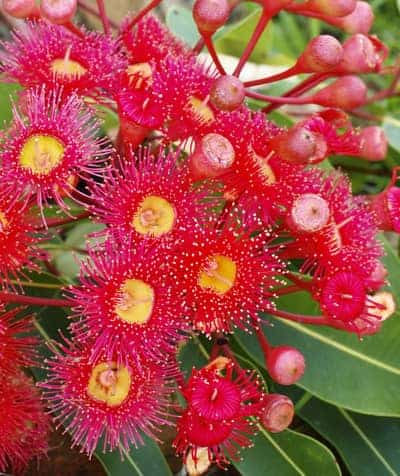
The Red Flowering Gum is one of Australia’s most beloved native trees, primarily due to its breathtaking floral display.
While the name suggests a fiery palette, the blossoms actually span a range of colours.
Its flowers can be bright crimson and scarlet to more subtle shades of pink and even brilliant orange, often all appearing on the same tree.
These vibrant blossoms are a feast for human eyes and provide nectar for various bird species, making the tree a hub of activity when in flower.
Typically, the Red Flowering Gum starts to showcase its vivid blooms in the summertime, around December and can continue to show off its colours well into March.
It’s a moderately sized tree, generally reaching heights of about 10 metres.
Although, in ideal conditions, it may grow taller.
Flowering Trees with Various Colours
Crepe Myrtle
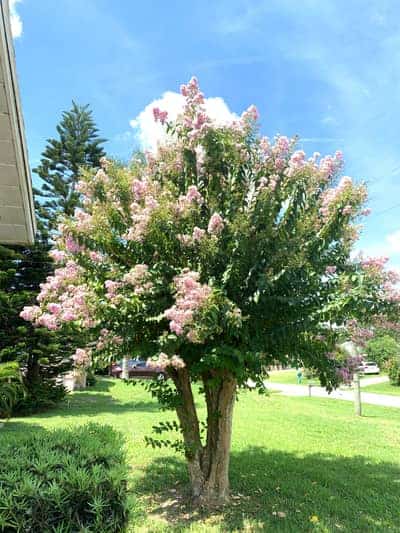
Crepe Myrtles (or Crape Myrtles) come from a family of deciduous trees renowned for their prolonged and vibrant flowering period in the hottest months.
Its blossoms display a range of colours, from white to deep reds and purples.
The Crepe Myrtle has smooth, mottled bark which peels away to reveal a fresh layer.
This tree ranges in size from small shrubs to 7-metre tall trees.
Adaptable and drought-tolerant once established, Crepe Myrtles are a popular choice for home gardeners across Australia.
Dogwood Trees

A flowering dogwood tree is an excellent aesthetic choice for a small yard.
They are more popular further south, where they thrive in cold winters and warm summers.
These deciduous trees grow to only 5 metres tall (but fairly wide!) and blossom in shades of white, pink, or red. The leaves run a beautiful scarlet in autumn.
A dogwood tree will thrive in regular garden soil so long as it drains well.
Keep it in the sun to fully enjoy its flower clusters in early spring.
Frangipani

Frangipani trees are small to medium in size, typically ranging from 5–8 metres in height, although some can grow taller.
They possess thick, succulent branches and a gnarled, distinct silhouette.
The flowers of the Frangipani tree are its crowning glory.
Blossoming in various shades — white, yellow, pink, red, and numerous hues in between — its flowers are waxy and have a strong, sweet fragrance, especially in the evening.
These trees bloom in summer and are common in areas of Australia with tropical climates.
Wisteria
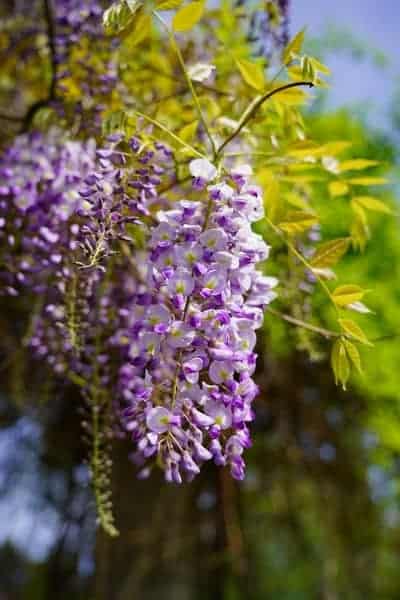
There’s an eerie sort of beauty to wisteria flowers trickling down from spindly branches.
These pink flowering trees (or yellow, lilac, or white) add a touch of fantasy to a garden, especially when they bloom in spring.
They’re slow to establish, sometimes taking years to start flowering. But once they do, the display of beautiful hanging flowers is worth it.
Grow wisteria where the weather is cool (or mildly tropical), in full sun and moist earth.
Fertilise the ground before planting. Water when dry, and prune mostly when young and developing.
And make sure they have good support — those branches and blooms can get heavy!
Frequently Asked Questions About Australian Flowering Trees
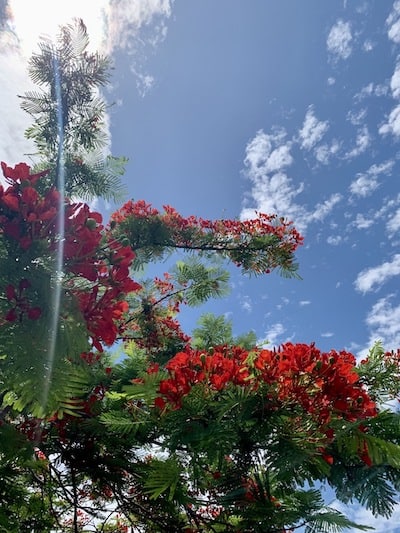
What flowering tree has the longest lasting blooms?
The Crepe Myrtle is known for its resilience and prolonged flowering period.
It begins blooming in summer, and the vibrant flowers last well into autumn, providing continuous colour for several months each year.
What flowering trees are in Brisbane?
Brisbane’s subtropical climate is perfect for a variety of flowering trees.
Frangipanis thrive in the city’s warm conditions with their fragrant, multi-coloured blooms.
The bright red flowers of the Illawarra Flame Tree and the purple blossoms of the Jacaranda are also widespread, particularly in older suburbs.
The Ivory Curl Tree is native to Queensland and adorns the city with its elegant, creamy white flowers.
What flowering trees are in Melbourne?
Despite its cooler climate, Melbourne is home to a range of flowering trees.
The city is well-known for its vibrant autumn foliage, especially from trees like the Golden Wattle.
The Pink Trumpet Tree and Crepe Myrtle are also common, adding pops of pink and various other colours throughout the city.
Melbourne’s urban landscape also sees a mix of native and non-native species, including the exotic Magnolia trees, which offer large, impressive blooms.

What flowering trees are in Perth?
Perth’s Mediterranean climate supports a wide array of flowering trees.
The Red Flowering Gum is a local favourite, displaying vibrant red flowers that attract birds.
Bottlebrush varieties are also prevalent, offering brilliant red brushes that stand out against the deep green foliage.
The Golden Wattle is also in the mix, introducing a bright yellow hue to the local flora palette.
What flowering trees are in Sydney?
Sydney’s temperate climate supports a variety of flowering trees.
The iconic Jacaranda is widespread, creating a stunning purple canopy in late spring.
The Illawarra Flame Tree is another prominent sight in Sydney, especially when it sheds its leaves and bursts into bright red flowers.
Golden Wattles also flourish here, offering a splash of yellow in the green landscape.
One Flower, Two Flowers, Tree Flowers, and More!
When caring for trees — flowering or otherwise — it’s important to ensure good ground drainage to prevent root damage and give them plenty of sun.
Check with a gardening professional if a tree needs regular pruning (some don’t!), and use a good mulch to help its growth.
It’s also worth checking the zones where a flowering tree will thrive to ensure you’re getting one appropriate for your climate.
Beyond that, simply let them grow and enjoy these stunning flowering trees in Australia.

